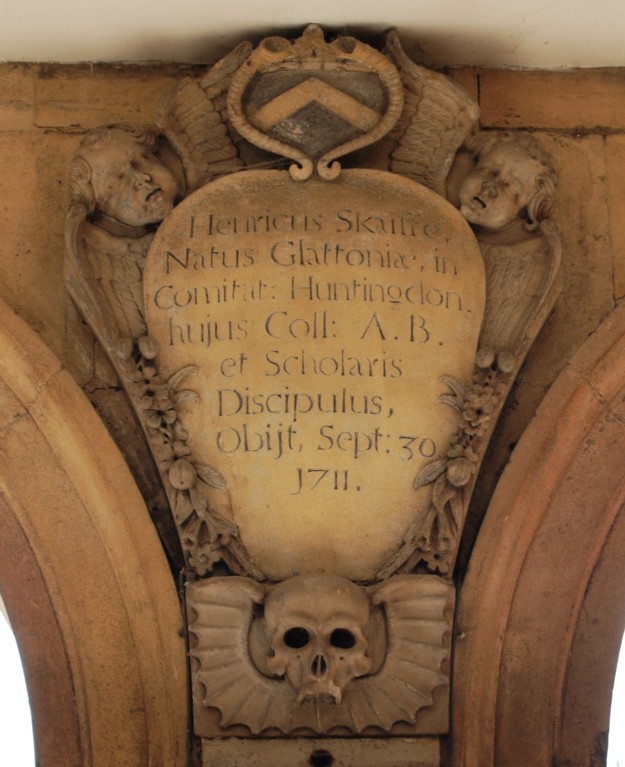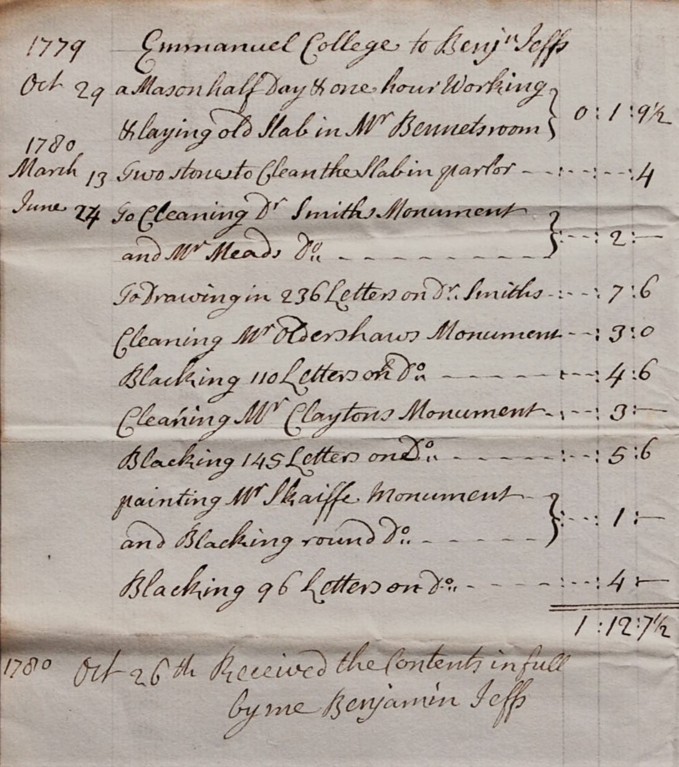Blog
14 July 2022
.JPG)
The chapel cloisters at Emma contain many eighteenth and nineteenth century monumental inscriptions, most of them commemorating Masters and Fellows. There are also several memorials to undergraduates, but this may not be immediately apparent, as they are invariably written in Latin (occasionally embellished with Greek) and often record only the date of death, and not the age, of the deceased. The death of an undergraduate was not the shockingly rare event, two or three hundred years ago, that it is today. The burial records of the parish of St Andrew the Great, in which the college lies, record the names of 42 Emma students who died in the period 1600-1800, but the true figure was much higher. For one thing, the burial registers do not always note collegiate membership, and for another, the bodies of many students were conveyed home for burial. Of the remainder, most were laid to rest in the parish church or its graveyard, but a handful were buried in the college.

Above; Henry Skaiffe’s monument
The young men interred in Emma’s cloisters are: Henry Skaiffe, Scholar (d.1711, shortly after taking his BA), Anthony Askew (d.1747, in his third year) and James Dusautoy (d.1815, in his second year). There are also monumental inscriptions commemorating Francis Oldershaw and James Mead, two graduates who died in their mid-twenties. The most striking of the student memorials is undoubtedly Henry Skaiffe’s. Its laconic wording contains none of the hyperbole so often present in lapidary inscriptions, but the encircling carving is enjoyably ghoulish. It includes an armorial, two grief-stricken cherubs and a particularly macabre rendering of the skull-and-batwings emblem occasionally found on tombstones of the period. Equally intriguing, to the curious-minded, is the fact that just across the cloister, the stonework between two of the arches bears unmistakable marks of having once supported a plaque of similar dimensions to Skaiffe’s. There are no photographs of this lost memorial, and as the identity of the man it commemorated passed from memory many years ago, its ghostly outline seemed doomed to remain an enigma.

Above; Stonemason’s bill, 1779-80
A recent discovery in the college archives, however, has established that the monument almost certainly commemorated a student who died in the early 1730s. A stonemason’s bill of 1779-80, itemising work carried out on the cloister memorials, includes a charge for the blacking of 145 letters on ‘Mr Claytons Monument’. Since all the other memorials listed on the bill are still in place, it follows that this one must be the missing plaque. The man in question was Humphrey Clayton, who was admitted as a pensioner in June 1730 and matriculated the following year. According to historical notes compiled in the 1770s and 1780s by William Bennet, an Emma Fellow, Humphrey came from Norfolk and was a scholar at the time of his death, which occurred in college. The parish register of St Andrew the Great records Humphrey Clayton’s interment on 3 January 1732.
It seems likely that Humphrey was the son of the Revd Humphrey Clayton, rector of Kenninghall and vicar of Bressingham, Norfolk, who was also an Emma man. He graduated BA in 1703 and later gave £10 towards the rebuilding of the Founder’s Range in Front Court. We will never know what poor young Humphrey’s monument looked like, or be able to read his epitaph, but we can at least now add his name to the select roll of Emma students who lie beneath the flagstones of our chapel cloister.
[Since writing this article, additional information has been found in Charles Henry Cooper’s Memorials of Cambridge (1861). Writing of the monumental inscriptions in Emmanuel’s chapel cloister, Cooper notes: ‘There was also a tablet in memory of Humphrey Clayton, student, son of Humphrey Clayton of Brisingham, Norfolk, clerk, 1731, aet.19. This fell down a few years since, and was thereby broken into so many fragments that it could not be replaced’. ]
Amanda Goode, College Archivist
Back to All Blog Posts